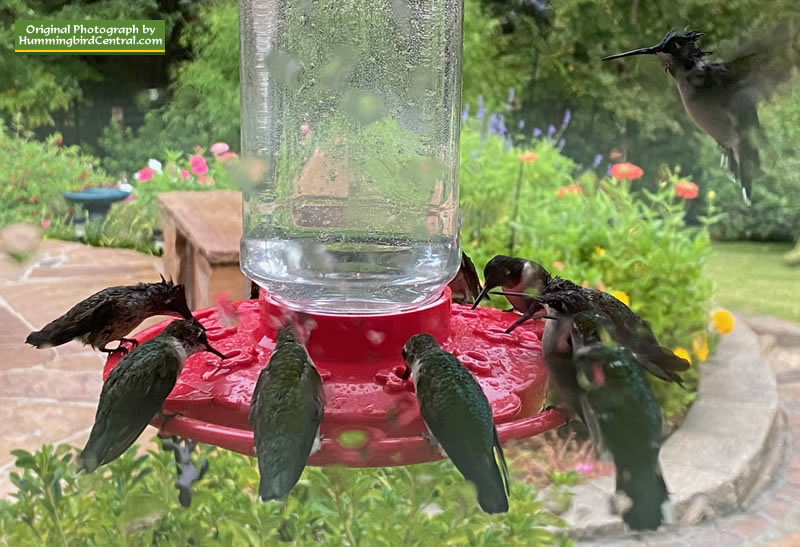Spring 2020 Hummingbird Sightings and Migration Map
The Urge to Migrate
 Rain makes Ruby-throats thirsty! Scene at our yard, September 8, 2020, approaching peak fall migration |
Many hummingbirds spend the winter in Central America or Mexico, and migrate north to their breeding grounds in the southern United States as early as February, and to areas further north later in the spring.
Hummingbirds fly by day when nectar sources such as flowers are more abundant. Flying low allows the birds to see, and stop at, food supplies along the way. They are also experts at using tail winds to help reach their destination faster and by consuming less energy and body fat.
Research indicates a hummingbird can travel as much as 23 miles in one day. However, during migration as they cross the Gulf of Mexico they may cover up to 500 miles at a time. Their average speed in direct flight is in the range of 20-30mph, and up to three times that fast during courtship dives.
During migration, a hummingbird's heart beats up to 1,260 times a minute, and its wings flap 15 to 80 times a second. To support this high energy level, a hummingbird will typically gain 25-40% of their body weight before they start migration in order to make the long trek over land, and water.
The first arrivals in spring are usually males. Some, however, do not migrate, in areas like California and the upper Pacific coast.
Highlights of 2020 Migration Activity
| Interactive 2024 hummingbird migration and sightings map |
| Interactive 2023 hummingbird migration and sightings map |
We typically monitor the spring hummingbird migration from early January into May of each year, with the help of our viewers as they submit their first hummingbird sightings in their areas.
The 2020 migration is over, and we have ended our mapping project for the year.
- Ruby-throated hummingbirds have reached their northernmost migration points. The front line of the migration has moved into Alberta, Manitoba, Saskatchewan, Ontario, Quebec, New Brunswick, Prince Edward Island, and Nova Scotia.
- Black-chinned hummers have advanced through central Texas into Oklahoma, New Mexico, Colorado, Utah, Idaho and further northwest.
- Rufous have been spotted through California and Washington up into southern British Columbia in places like Victoria and Whistler as well as Alberta. And we have had reports from Juneau and Seward in Alaska ... they are our northernmost hummingbird sightings of 2020.
- Broad-tailed hummingbirds have been sighted during their migration through New Mexico, Colorado, Wyoming and Idaho.
- Calliope sighting reports have been received in several areas, many in the greater Spokane area in eastern Washington, and up into Canada
- Anna's stay year-round in locations along the West Coast, and we have recieved multiple reports of their current locations.
- Allen's are being spotted in California, from San Diego in the south, northward up into the Oakland area.
The Final 2020 Migration Map
Shown below is our final map of hummingbird sightings in 2020 across the U.S. and Canada, as reported by our website viewers. In 2020 we received over 13,000 "first sighting reports". The map has been viewed over 9,300,000 times !
Here are some points and policies to note about the posting of reports on our migration map:
|
2020 Hummingbird Spring Migration Interactive Map
|
|
|
More About the Spring Hummingbird Migration
During migration, a hummingbird's heart beats up to 1,260 times a minute, and its wings flap 15 to 80 times a second. To support this high energy level, a hummingbird will typically gain 25-40% of their body weight before they start migration in order to make the long trek over land, and water. They fly alone, often on the same path they have flown earlier in their life. Young hummingbirds must navigate without parental guidance.
Hummingbirds fly by day when nectar sources such as flowers are more abundant. Flying low allows the birds to see, and stop at, food supplies along the way. They are also experts at using tail winds to help reach their destination faster and by consuming less energy and body fat. Research indicates a hummingbird can travel as much as 23 miles in one day.
Strong cold fronts moving south over the Gulf make flying difficult as the birds deal with headwinds and heavy rain, over long distances with no shelter. Food is non-existent over the open waters.
Read more details about hummingbird migration
The Fall Hummingbird Migration
By August and September, hummingbirds are moving south, refueling their bodies in the early morning, traveling midday, and foraging again in the late afternoon to maintain their body weight.
Ruby-throats gather in Florida, Louisiana and along the South Texas coast in September in preparation for the final push to the south, either over the Gulf of Mexico or via an overland route through Mexico. The Rufous hummingbirds head south, most via the eastern range of the Rocky Mountains. Read more about the fall migration of hummingbirds
